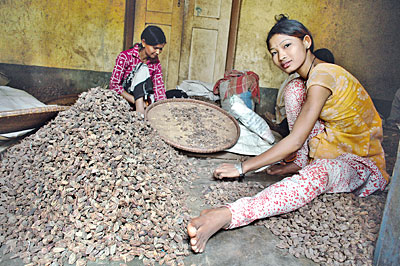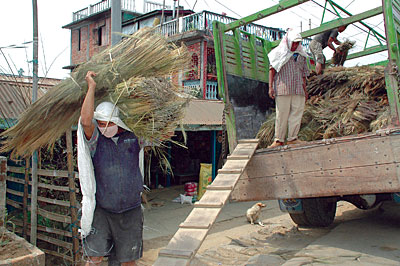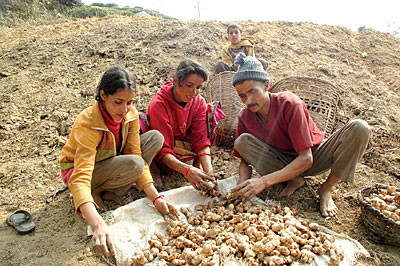 SOHAN SHRESTHA |
Federalism throws up more questions than answers, but the eastern region's current setup has tremendous potential. Indeed, various development indexes show it is ahead of other regions. Despite the anxieties roused by communal sentiments, the east retains the integrity of its social fabric, and not even the Madhes movement seriously disrupted this.
Geographic diversity is the chief asset of the region. The Tarai plains are fertile for agriculture, the hills are suitable for cash crops, and the mountains for medicinal herbs and hydropower potential. The eastern region also has a store of copper, iron and stones. The region leads the way in infrastructure and industry as well as on political and educational fronts.
The liberalisation of the economy after 1990 boosted commercial production of agricultural and dairy products. Agro-based products such as tea, cardamom, ginger, and medicinal herbs, among others, have hit it big in the international markets.
Sixty years ago, there were a mere eight industries in the east. Today there are over 800 in operation. Cities in the eastern Tarai such as Biratnagar are economic hubs, and well-connected district headquarters are following suit.
Agriculture expert Madan Rai (see box, left) says, "Scientific farming and its commercialisation will help the region prosper, and farmers here will own a car and have their houses connected to roads within two decades."
A cup of prosperity
 ALL PICS: DAMBAR KRISHNA SHRESTHA |
Moti Ram Dahal returned to Ilam from Qatar, disappointed that he could earn only Rs 10,000 a month, despite working long hours. Now, eight years after coming back home, he can hardly keep count of his income. Dahal, along with his relatives, invested Rs 600,000 and revived his tea plantation. The plantation now produces 4,000 kg of tea yearly, earning him profits of a million rupees. His brand, Dahal Bandu Orthodox Tea, is a popular buy in the market. Now the head of Pathibhari Orthodox Tea Industry, Dahal is planning to purchase a new machine worth Rs 4.9 million. He even stopped his brothers from migrating for work. "Why go elsewhere when our own farming here can reap such profits?"
Cashing in on crops
 |
In 1969, 20-year-old Obindra Bahadur Yakkha of Sumbek, Ilam, had 6 ropanis of land (about 3,000 square metres) and 6 siblings to feed. Last year, Yakkha earned Rs 54,000 from milk, Rs 265,000 from oranges, Rs 125,000 from amriso (used to make brooms), Rs 150,000 from garlic and Rs 50,000 from chilies. He now owns 80 ropanis of land (almost 41,000 square metres) and a house in Ilam bajar worth Rs 1.4 million. Recently he was able to give away 35 ropanis of land (almost 18,000 square metres) to each of his three brothers. Yakkha, who has been felicitated by the District Agricultural Office many times, says all this is the result of his investment in cash crops.
Untapped energy
 |
Diversity counts
Interview with Madan Rai, agriculture expert
Why do you think that the eastern region has been able to progress more, compared to other development regions? 
The progress of the region can be attributed to the combination of apt weather, fertile lands, education and the commercial skills of the people.
What is the importance of geographical factors in development?
Most countries in the world are either too hot or too cold. Nepal however is blessed with snow-capped mountains, green hills and fertile plains. The herbs and produce of the mountains and the hills have found a huge market in the Tarai and vice versa. Let's hope that the proposed federal model will not disturb this balance. Otherwise the basis of the progress of the eastern region will be lost. When dividing states, the model has to allow coordination between the north and south.
Are you against ethnic states?
My belief is that the basis of peace and progress should not be broken when a particular ethnic group gets its political rights. Development will definitely speed up after the states are established, but no one will benefit if the geographic dependency of economic development is destroyed.
What can be done to make the eastern region more developed?
If everyone honestly performs their responsibilities, the whole country will develop. The teachers should produce able manpower, the civil servants should perform their duties well. Our country is a storehouse of water and electricity. In 20 years I think it is possible to build roads to every house, even in the hills.
Of cardamom, ginger and amriso
If you take a trip to eastern Nepal, the sweet smell of cardamom is sure to greet you. Cardamom, ginger and amriso (broom grass) are the cash crops helping farmers in eastern Nepal make money, and plenty of it. Mostly grown in Taplejung and Sankhuwasabha, these crops are also the favourites of farmers in Panchthar, Ilam and Terathum. Many farmers in Bhojpur and Khotang are also profiting from cardamom farming. Birendra Yongya of Panchthar and Phurwa Sherpa of Dhading both grow 4,000 kg of cardamom every year. Ram Bantawa of Lungrupa 4, Panchthar, says that cardamom farming has benefitted 180 families of his area. Chedam Sharma of Sankhuwasabha, Dhading, says: "Cardamom is what buys food, salt and gold in our houses."
Taplejung alone produces Rs 12 million worth of cardamom. According to Dinesh Mittal, Chairman of Nepal Cardamom Traders Association, 10,000 tons of cardamom worth Rs 70 million are exported from the eastern region, travelling through India to Pakistan and the Gulf. This year the rate was Rs 50,000 per 40 kg and prices have been rising every year.
Chairman of the eastern region's Broom Traders Association, Ram Chandra Chaudhary, says that almost 13 tons of amriso worth 1.15 billion are exported every year. According to Raj Kumar Karki, Chairman of the Ginger Producers and Traders Association, 95 per cent of the 13 tons of ginger produced is exported to India.
 |
 |
 |
READ ALSO:
Village forests go through midlife crisis , RUBEENA MAHATO
Cycling recyclers


